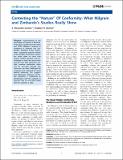Files in this item
Contesting the “nature” of conformity : what Milgram and Zimbardo's studies really show
Item metadata
| dc.contributor.author | Haslam, Alexander | |
| dc.contributor.author | Reicher, Stephen David | |
| dc.date.accessioned | 2012-11-23T11:01:02Z | |
| dc.date.available | 2012-11-23T11:01:02Z | |
| dc.date.issued | 2012-11-20 | |
| dc.identifier.citation | Haslam , A & Reicher , S D 2012 , ' Contesting the “nature” of conformity : what Milgram and Zimbardo's studies really show ' , PLoS Biology , vol. 10 , no. 11 , e1001426 . https://doi.org/10.1371/journal.pbio.1001426 | en |
| dc.identifier.issn | 1544-9173 | |
| dc.identifier.other | PURE: 38007745 | |
| dc.identifier.other | PURE UUID: 08083170-189e-4c44-98c1-d9a8c8f4da4d | |
| dc.identifier.other | Scopus: 84870272328 | |
| dc.identifier.uri | https://hdl.handle.net/10023/3264 | |
| dc.description.abstract | Understanding of the psychology of tyranny is dominated by classic studies from the 1960s and 1970s: Milgram's research on obedience to authority and Zimbardo's Stanford Prison Experiment. Supporting popular notions of the banality of evil, this research has been taken to show that people conform passively and unthinkingly to both the instructions and the roles that authorities provide, however malevolent these may be. Recently, though, this consensus has been challenged by empirical work informed by social identity theorizing. This suggests that individuals' willingness to follow authorities is conditional on identification with the authority in question and an associated belief that the authority is right. | |
| dc.language.iso | eng | |
| dc.relation.ispartof | PLoS Biology | en |
| dc.rights | © 2012 Haslam, Reicher. This is an open-access article distributed under the terms of the Creative Commons Attribution License, which permits unrestricted use, distribution, and reproduction in any medium, provided the original author and source are credited. | en |
| dc.subject | BF Psychology | en |
| dc.subject.lcc | BF | en |
| dc.title | Contesting the “nature” of conformity : what Milgram and Zimbardo's studies really show | en |
| dc.type | Journal article | en |
| dc.description.version | Publisher PDF | en |
| dc.contributor.institution | University of St Andrews. School of Psychology and Neuroscience | en |
| dc.identifier.doi | https://doi.org/10.1371/journal.pbio.1001426 | |
| dc.description.status | Peer reviewed | en |
This item appears in the following Collection(s)
Items in the St Andrews Research Repository are protected by copyright, with all rights reserved, unless otherwise indicated.

